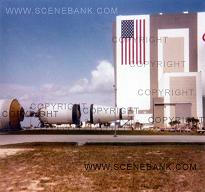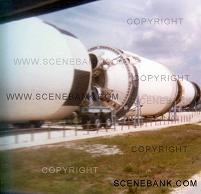| Surfing, Movies, & More! |
|
Movie Review: Planet of the Apes by: Joe the Reviewer Sept. 18, 2011. Copyright: scenebank.com **** Spoiler alert! This review reveals major plot elements of the film Planet of the Apes.
Planet of the Apes
(2001, directed by Tim Burton)
While on the run, Davidson meets up with thousands of other human savages who had been hiding in the wilderness and wages a battle against the ape army that pursued him from the ape city. During the heat of battle, a space capsule lands right in the middle of the battlefield, and from the capsule emerges Davidson's chimp-friend that he knew in 2029. Both Davidson and the new chimp had been transported to the same planet at roughly the same month in time (plus or minus a few days). The ape-human battle suddenly ceases and both the apes and humans look agape at the mysterious new chimp with the technologically-advanced spaceship. The apes are persuaded by the humans to take care of the chimp astronaut, while Davidson is allowed to leave the planet in the chimp's spacecraft and return back to his own time. Once in space, Davidson's capsule is somehow redirected back into the same space-storm that had brought him to the ape planet in the first place. He goes through the time-space storm again, and his ship is transported back in time to something later than 2029 (it's many decades later — in the year 2155). But the year is still earlier than on the ape planet he had escaped. Davidson again crash-lands, but this time he crash-lands on Earth in Washington, D.C. The film ends with Davidson staring at a famous statue but it's not of a marble Abraham Lincoln seated at his marble chair, rather it's the giant marble statue of an ape general but with the same pose as Lincoln's statue. It seems that in the year 2155, the apes had also overtaken humanity on Earth. Davidson, to his horror, is captured by armed ape police in police cars. The film ends with a sense of doom, that apes had become not just smart enough to be stone-age/iron-age conquerors as on the recently-visited ape planet, but smart enough to be computer-age conquerors who can make automobiles, guns, helicopters, and radios here on Earth. Positives: Actress Estella Warren is a very pretty actress. She played a supporting character (one of the 'wild' humans who gets captured along with Captain Davidson). Warren definitely caused some on-screen sexual tension with the star, Mark Wahlberg. In Planet of the Apes, we do get a sense of the peril that mankind has faced. We never see the apes overthrow Man in the movie, but it is implied — it has taken place in the past, and the viewer sees this through the protagonist Davidson. It is especially doom-filled at the film's end, when Davidson realizes he cannot escape ape rule. The film is yet another warning of Man's ingenuity coming back to bite him. In this way, Planet of the Apes resembles Frankenstein or The Terminator.
Lukewarms:
Negatives: Time Travel. Although human time travel is currently impossible, it is a common Sci-Fi movie element. The viewer must temporarily suspend reality while watching such a Sci-Fi adventure film. However, it seems more plausible to me if time-transport goes in only one direction. The time machine in Back to the Future was deliberately designed to move objects back and forth in time, so it seems more plausible. Instead, in Apes, Captain Davidson is first transported by the space-storm into his future, then back again into his past. That seems too much to believe for a physical phenomenon like a space storm. Why would a random space storm change time both forward and backward? The film was set in 2029. That's only 28 years from 2001. Somehow this is too short a timespan for human beings to have giant space stations that explore other planets. Even genetic DNA splicing with human DNA seems like it should be far later in human future than 28 years. The ethical aspects of DNA manipulation are still being figured out today, so the movie seems like it should be set in a far later time, like in the 22nd or 23rd centuries, for example. There are three plot holes I can think of: On the aforementioned breasplate armor, there were many symbols from an ape-language. If the apes speak English, then what is the meaning of the strange characters that are not from the English alphabet? The apes should have their own language if they have their own alphabet, no? Also, how did the apes acquire speech, if they could not talk on the original spaceship Oberon back in 2029? The engineered-chimps and other apes in 2029 were more monkey-like, and could not yet speak. So how did the apes come to speak at all, and why would they be speaking English if no human had ever taught them English? There are human beings on the ape planet. How did humans get there in the first place? We are told later in the film, that Captain Davidson's mother-spaceship Oberon had crash-landed on the ape planet and all the humans were killed by the ape escapees. Yet there are thousands of humans on the ape-planet. How did any founding humans get on the ape planet at all? On the ape planet, the apes rode horses. Where did the horses come from? We saw no evidence of horses on Davidson's space mothership Oberon back in 2029. The only possible source of horses would be from the space mothership that had crashed many centuries ago. So how did horses get onto the new ape planet?
There was one bad dialog moment. It was between Captain Davidson and a female chimp that sympathized with humans.
Trivia:
Overall: The 1968 movie had a more serious tone. The original film suggested more of an ape culture with real differences between the chimps, orangs, and gorillas. It showed a more complex ape society, with its own internal ape species biases that the 2001 film lacked. Unlike, the 2001 film, the 1968 movie took place on Earth, so it is not a real stretch to imagine horses still existed after a nuclear-war. Whereas, in the 2001 film, we don't ever find out where the horses came from, so it's a puzzle. The original 1968 film had more of a sense of ape-superiority (because their humans couldn't speak, there was little evidence of humans being smart). Because they couldn't speak, the wild humans used a few hand gestures to communicate. Contrast this with the 2001 film version where humans spoke. Humans speaking made them seem more intelligent, despite being below the apes. This was a relative deficiency in the 2001 movie. The original 1968 film had much more of a message about mankind: that man's warlike nature will be his downfall. The 1968 film even had the advantage of being released during the Cold War between the United States and the Soviet Union, with all its potential for an apocalyptic nuclear battle. The Burton version of Planet of the Apes film has less of that feeling of impending human-caused self-destruction. The 2001 film seems to show a human-caused laboratory accident gone wrong, rather than man's downfall due to his bellicosity. Still, both the new movie and original one are warnings about human technology gone awry. The 1968 film was a serious movie with some funny dialog. While the 2001 Burton version was perhaps too funny, which distracted from the challenges that protagonist Davidson must be feeling.
Still, despite some flaws in the film, Burton has created a watchable film that would have been entirely different without him. The Burton version benefits from CGI special effects that were impossible in 1968. For modern audiences who never saw the 1968 version of Planet of the Apes, the 2001 version is a useful introduction to the Apes franchise, and would be enjoyable to them. To someone who has seen the 1968 version, the new 2001 film is good in its own right, and an interesting addition to the Apes franchise. While there were some flaws in the film, the 2001 version of Planet of the Apes was still a good movie.
|
|---|

 image0014 image0014NASA Saturn V & bldg. |
 image0015 image0015NASA Saturn V display |
 image0016 image0016NASA Saturn V display |
For your viewing pleasure → This video
was shot on a nice sunny summer day of 2007 in southern California, USA |
 Phone/Normal/HiDef
Phone/Normal/HiDef
Views:
Format: WMV
Length: 4:14 min.
Size: 138 MB |
|---|
Site Map